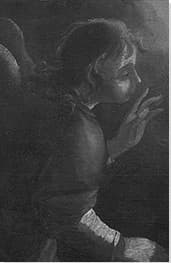Summary of Josefa de Óbidos
Josefa de Óbidos was the most celebrated female artists in 17th century Portugal. She excelled in several different fields of arts and crafts production but she is best known as a painter of still lifes and devotional narratives. Óbidos's art typically reflected her strong Catholic faith, and she is today considered one of the most authoritative exponents of the Baroque style in Portuguese art. Moreover, in a situation that was highly unusual for a woman of her time and place, Óbidos never married, preferring a life of independent means. Indeed, she ran her own successful studio and became wealthy from many prestigious public and private commissions.
Accomplishments
- Óbidos's most iconic works portray women as what might be called "Baroque heroines". These figures reflected her own affinity with female religious figures and spoke of the way in which she had herself elected a day-to-day life of religious piety. As the historian Lucas Brandao put it, "In the field of the fullness of her figurativism, Josefa opened the book and composed a universe that always sought the transcendental, at the same time that she crossed it with an esteem for what is natural and human".
- Óbidos's still lifes are often associated with a Sevillian genre known as Bodegón. The term is applied to still life compositions depicting food items, often placed next to kitchen or other household utensils and receptacles (although in the hands of the great Spanish artist, Velázquez, the genre was stretched to blend still life and genre scenes). Óbidos's still lifes were adorned with objects from everyday Portuguese scenes such as conventual sweets (sweets and cakes made in convents by nuns), flower garlands, textiles, ceramics, and baskets.
- Portuguese art of the 17th century has often been accused of embodying a Castilian provincialism. Indeed, Óbidos's art embodied a Spanish Baroque style that was based on a play on light and shadow and the skillful use of color. Yet Óbidos added a festive and decorative dimension that was unique to Portuguese art and culture. As historian Fátima Muralha put it, Óbidos "did not hesitate to cover [her devotional pieces] with a certain decorative character [...] small flowers appear scattered throughout the compositions [and] clothes and ornaments [provide us] with ethnographic information" about 17th century Portugal.
- Óbidos earned fame and financial success during her own lifetime. She secured many commissions for portraits and still lifes from important public and private clients, working on many of Portugal's most prestigious religious buildings and monasteries, and painting portraits of prominent public figures, including members of the Portuguese royal family. Indeed, her reputation grew to such an extent that her studio became an attraction for local noble women.
The Life of Josefa de Óbidos
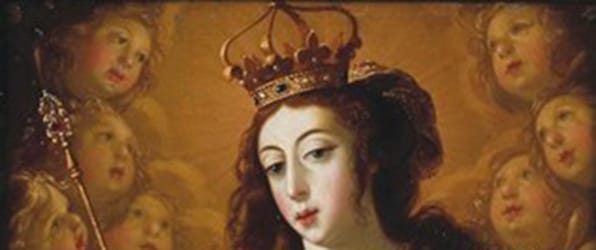
Challenging the charge that 17th century Portuguese art was provincial, and was technically "lesser" than the art of its Spanish neighbors, art historian Souren Melikian makes the counter-argument that Óbidos possessed "a poetic feeling that redeems much of her work," and that her "softness comes through in almost every religious subject" in works that exude "an extraordinary sense of intimacy".
Important Art by Josefa de Óbidos
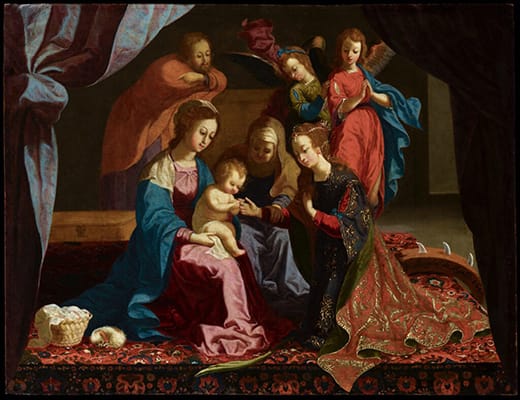
The Mystic Marriage of St. Catherine
In this, Óbidos's first signed extant painting, produced for the Augustinian Monastery of Santa Cruz in Coimbra, we see St. Catherine of Alexandria in a lavish dress in front of her characteristic broken wheel, kneeling beside the Christ child who sits on the lap of the Virgin Mary, as they engage in a "mystical marriage", symbolizing the betrothal of her pious soul to the Lord. At the top left a man in a red robe observes the scene (possibly the hermit who led Catherine to Christianity). Two child-like angels at the top right also watch the scene, which takes place atop a decorative rug and is framed by two theatrical curtains of stiff drapery (a technique Ayala repeated in her various versions of Salome Presenting the Head of Saint John the Baptist). At the bottom left, a small dog (symbolizing marital fidelity) sleeps beside a basket. This is one of many small copper works that Óbidos produced of the mystic marriage of St. Catherine, and she took up the theme again in the largest panel of her altarpiece dedicated to Saint Catherine for the church of Santa Maria de Óbidos.
Óbidos, whose father owned a large collection of prints which they both copied, is believed to have taken this composition from a 1528 painting by Titian that would have been known to her from a 1565 engraving by Dutch engraver Cornelis Cort (which explains why her version is the reverse of Titian's). She produced at least four small works on copper of the same subject, which indicates that this was likely an exercise in repetition in order to improve her skills, and/or a form of portable proof of her strong talent as a teen (which would have helped her obtain further commissions). Her rendering of faces, and her inclusion of still life elements (such as the basket at the bottom left of the frame) shows the influence of Francisco de Zurbarán, with whom her father had studied in Seville.
Óbidos showed particular aptitude in rendering exquisite detail (such as on the dress and rug) on this miniature scale. Joaquim Oliveira Caetano, director of the Museu Nacional de Arte Antiga, Lisbon, explains that she "had a personal taste for clothes, rich fabrics and ornaments. The inventory of her possessions, made after her death in 1684, is full of embroidered ornaments, velvet and oriental silk clothing, lace, gloves, silver and gold embroidery, and a wealth of jewelry. In addition to the [wealth] that these garments and fashion ornaments document, they also show a clear personal taste that is also reflected in her reproduction of the textile diversity and the profusion of decorative ornaments she represented in her paintings".
Oil on copper - National Museum of Ancient Art, Lisbon, Portugal
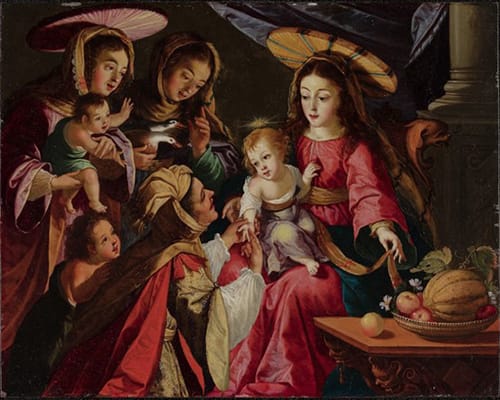
Reading the Fate of the Christ Child
In this work, which, according to expert on viceregal art, Jaime Eguiguren, depicted a subject that was "highly unusual for the time", Óbidos presents a scene in which the youthful Virgin Mary, wearing the head covering of (an Egyptian) gypsy, sits in a dark interior between a column and an ornate wooden table upon which sits a bowl containing a melon, apples, grapevines, and flowers. On Mary's lap sits the Christ child, who gazes curiously downward at an older gypsy woman kneeling on the ground who is holding his hand as she reads his palm. To the left of the scene, but nestled in closely, are two additional women, a baby, and a child. All four lean in intently, evidently curious about the scene that is unfolding before them. The only other object identifiable in the scene is a section of purple drapery just behind the Virgin's head.
Caetano notes that Óbidos often created very shallow scenes as a "strategy" to hide the fact that she was not very skilled in perspective. At the same time, however, this compositional choice serves, here and in her other works, to push the figures closer together, thereby increasing the sense of intimacy and emotional warmth that she was already so skilled at depicting in her figures' facial expressions. Says Eguiguren, Óbidos's "successfully infused this work with her enormous talent and inspiration [...] The scene is overflowing with unrivalled tenderness and warmth".
Caetano notes that, in addition to being a "decorative element", the column "is a strong iconographic element as a Christological symbol and as an image of faith", which she used in other religious works such as the Lactation of Saint Bernard (1670). As for her inclusion of a still life scene of fruit and flowers, no doubt inspired by the Flemish works she so admired, and serving here as a testament to her skill as a still life painter, Caetano recognizes the fruit as having symbolic meaning, with the ensemble indicating "the abundance and prosperity of fortune", the melon representing wisdom, and the apple linking to the idea of Mary "as the New Eve, conceived without sin and destined to redeem humanity from the faults of the primitive Eve".
Oil on copper - Detroit Institute of Arts, Michigan
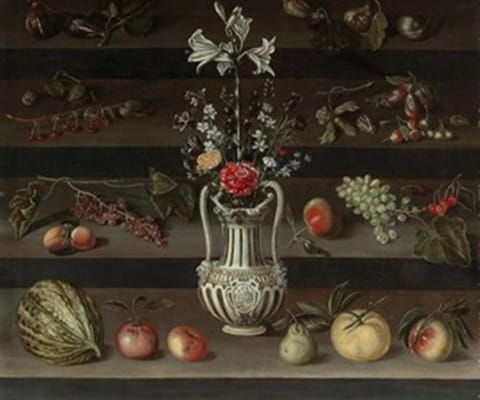
Lilies and Other Flowers in a Majolica Vase, with Peaches, Grapes, Cherries and Other Fruit Around, on Stone Steps
In this undated still life, Óbidos presents a horizontally composed scene on stone steps, with peaches, grapes, cherries, and other fruit laid out as if they were specimens on the steps. The central focal point is a tall, ornate, white vase containing an arrangement of flowers, the highest of which are white lilies, a likely allusion to the Virgin Mary. Óbidos painted several still lifes, which demonstrate the influence of Francisco de Zurbarán and Spanish still life painter Juan Sánchez Cotán, particularly in the use of vivid colors and of a rhythmic, geometric (horizontal and vertical) compositional arrangement. Moreover, Óbidos's still lifes are in fact often associated with the Sevillian genre known as Bodegón, which applies to still life compositions depicting food items placed next to everday household utensils and receptacles.
Art historian Souren Melikian considers Óbidos's still lifes to be her greatest works, stating that "Her religious paintings may be moving for what they tell us about her, but they remain provincial. In her still lifes, the painter sometimes equaled the greatest". She presents specimens of the natural world in precise detail, developing, as Melikian puts it, "a carefully contrived construction, lyrical in its handling of color and luminosity, and so rigorous that not one iota could be removed". Caetano adds that, as with the fabrics and jewelry of her religious paintings and portraits, in her still lifes she paints "inanimate things [...] with obvious ease and skill".
Oil on canvas - Private collection
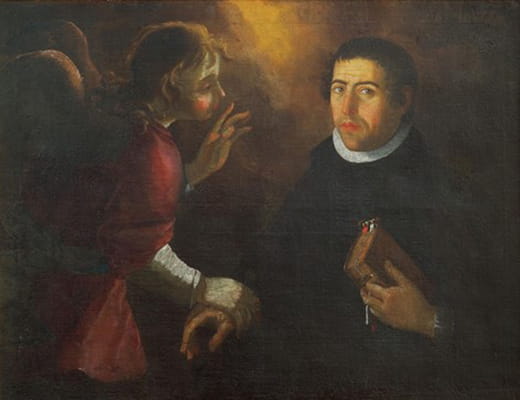
Portrait of Faustino das Neves
In this portrait, the subject (Faustino das Neves, a prominent beneficiary in the artist's town of Óbidos) is presented from the waist-up on the right-hand side, wearing a black coat over a high white collar, and clutching a book of the gospels to his chest with his left hand. A winged angel in red dress on the left side of the painting grasps the sitter's right hand with its own, while its left hand is raised softly near its face, and it looks at the subject peacefully. The background is comprised of dark clouds, illuminated softly from the centre, causing the image to be imbued with a dramatic sense of light and dark.
Óbidos was a talented portraitist, though few portraits have been definitively attributed to her. Her early biographer, Damiao de Froes Perym (the pen name of fray Joao de San Pedro) included her in his Theatro Heroino: Abecedario Historico, e Catalogo das Mulheres Illustres em Armas, Letras, Acçoens Heroicas e Artes Libera (Catalogue of Illustrious Women) (1736-40), and even though, of her approximately 150 known works, the majority are still lifes and devotional paintings, Froes Perym focuses almost exclusively on her portraiture.
Art historian Julia K. Dabbs suggests that this bias on portraiture "might be attributed to several factors: (1) the Theatro heroino was dedicated to the Queen of Portugal; (2) artists were often associated with nobility by early modern biographers in order to elevate their social status; (3) portraiture was privileged in importance and skill over still lifes in the early modern hierarchy of painting genres, thus enhancing Ayala's reputation; and (4) portraiture was considered a medium especially congenial to the skills of women artists, who did not have the benefit of academic training but were thought to be of replication". Yet Dabbs concludes that "We should also be open to the possibility that Ayala was indeed a gifted portraitist," and that "her Portrait of Faustino das Neves [...] demonstrates a penetrating and innovative approach to portraiture". By this point in her career, Óbidos's had already established herself as a talented painter of religious scene, therefore it is likely that she was sought out by members of the nobility to paint portraits that emphasized the sitters' religious devotion.
Oil on canvas - Museu Municipal de Óbidos, Portugal
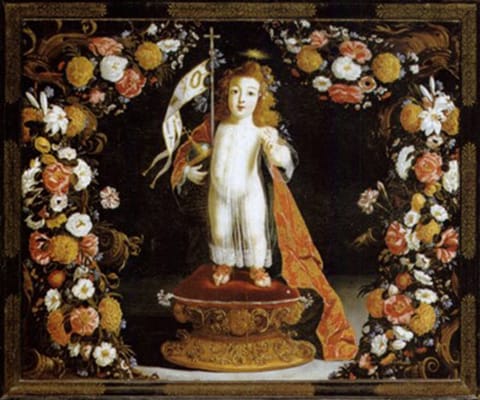
Christ Child as Salvator Mundi
Toward the end of her life, Óbidos produced several paintings depicting the Christ Child as Salvator Mundi (savior of the world). In each, Jesus is shown as a toddler standing on an ornate pedestal, gazing softly at the viewer. With his left hand, he makes the sign of blessing, and tucked under his right arm are an orb (divided into three parts, symbolizing the Earth with the three continents known to Europeans prior to their arrival in America: Europe, Africa, and Asia, and surmounted by a cross, which represents Christ as the savior) and a gold and white flag. Above Jesus's head is a halo suggested by radiating rays of light. His body is naked, covered by a garment of transparent lace. In this version of the Salvator Mundi, Óbidos surrounds the composition with a wreath of colored flowers, a common device used in religious paintings of the time in Portugal, which Óbidos, an accomplished still life painter, embraced in many of her works.
Art historian Rachel Zimmerman notes that "Like many other women, such as the Italian painter Sofonisba Anguissola, Ayala often emphasized feminine virtues in her work. The Christ Child as Salvador Mundi highlights religious devotion, and maternal affection [...] She shows Jesus naked with the plump body of a baby to emphasize his innocence and vulnerability. To maintain the chaste reputation expected of an unmarried woman, Ayala added a translucent gown with strategically placed folds that catch the light and hide the figure's genitals".
Zimmerman goes on to explain that "Women were encouraged to foster a maternal relationship with the Christ Child in emulation of the Virgin Mary, such as women who became nuns. When entering the convent, girls would sometimes receive dolls of the Christ Child. They acted as mother to the doll while also being spiritually married to Jesus as nuns. If Ayala indeed lived in convents, she may have participated in the care of a Christ child doll. Her personal experience with such a doll could have been one reason why she made multiple paintings of the Christ Child". The sweetness with which the artist renders the figure and expression of the Christ child indicates, according to art historian Souren Melikian, a particular "soft spot" she felt for children.
Oil on canvas - Igreja Matriz de Cascais, Portugal
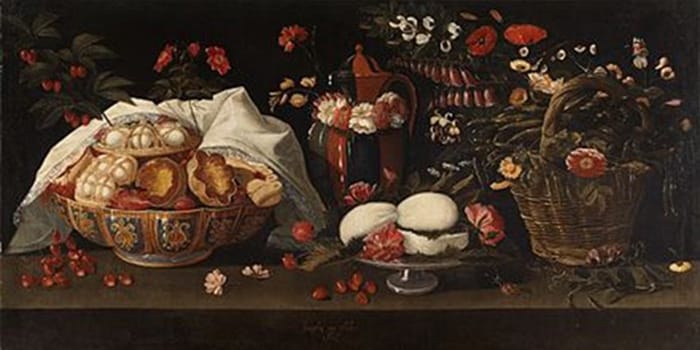
Still Life with Flowers and Sweets
Óbidos's still lifes carry the influence of Flemish, Dutch, and Spanish schools. Still Life with Flowers and Sweets embodies a serene simplicity in which the sweets, pottery and flowers allow the artist's delicate use of colors to "breath life" into her still lifes. Óbidos's dark background and subtle use of different white tones, which heightens the dramatic impact of the painting, can be read as a common feature of Northern Baroque styling. For all its technical assurance, the work has sometimes been overlooked for a certain lack of authenticity. As the historian Fátima Muralha put it, "The annexation of Portugal by Castile" had condemned "the literary and artistic production carried out in Portugal to a certain provincialism". Yet the artist brought a prestige to her still lifes that were unique to own life and to that of the municipality of Óbidos (Portugal).
From the artist's own perspective, one can read Óbidos's still life as an allegory for Christian and conventual life. Here we can identify Christian symbols most obviously in the ceramics and conventual sweets, those being sweets and cakes made in local convents by nuns, and to where Óbidos had herself retreated for two years.
Offering a conjunctional analysis of Still Life with Flowers and Sweets, and its companion piece, Still-life with Pastry, Terracotta Jars and Flowers (1676), historian Susana Alves adds, it is "possible to establish a connection with the Baroque discourse of the Counter-Reformation in which the gesture and behavioural excesses of human nature stand out, in contrast to the principles and values of purity and simplicity. Valuable objects and luxurious embroideries are represented together with white roses, representing the spirit of patience and red roses, associated with spiritual martyrdom. Exploiting her knowledge of symbols and the significance of plants, the artist turns each detail into a symbol of reality and man's spiritual values. Thus, the cherries and roses symbolise happiness, maternal love is suggested by the carnations and eternal life is characterised by the butterfly".
Oil on canvas - Museu Municipal de Santarém
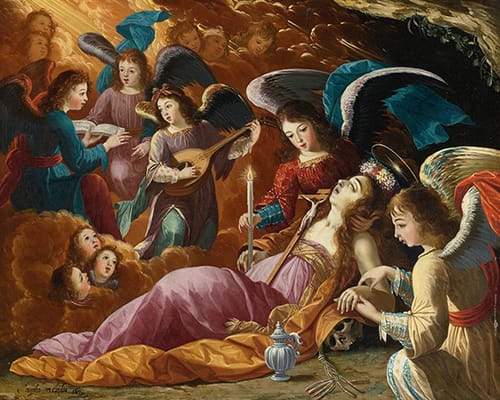
The Penitent Magdalene Comforted by Angels
This painting on copper, a relatively late work by the artist, demonstrates the artist's piety. Mary Magdalene, dressed in rich pink satin robes, is depicted at the moment of her conversion, swooning in ecstasy on the ground, surrounded by a host of jubilant angels, some of whom play music. She is accompanied by her typical attributes representing penance, including a jar of ointment, a skull, and a scourge. Upon her head sits a crown of flowers, and above that, a fine halo is visible, with a sunburst of light at its centre. In typical Baroque style, the scene takes place against a fantastical, nonspecific, swirling atmospheric background. The composition is dominated by burnt orange and deep teal, and the scene is illuminated by a central candle held by one of the angels.
The influence of Óbidos's father's friend and mentor, painter Francisco de Zurbarán, can be seen here in the use of touches of white and cream to create a sense of luminosity, as well as in the facial expressions and the texture of the fabrics. Caetano, asserts that this is one of Ayala's most interesting paintings, and one of the finest examples of her skilled use of tenebrism. Its subject matter, and the affectionate style in which it is represented.
Summing up Óbidos's career, historian Lucas Brandao writes that, "It is important to clarify social and political aspects, which help to contextualize a female presence on the painting stage, something that was unusual, given that women, even in the Modern Age, saw their role restricted to domestic chores and manual work, in addition to the tasks associated with motherhood. Nevertheless, and even in Portugal as troubled as it was in the 17th century, still having to deal with questions of independence, there was space for artistic manifestations, so necessary to give color and shape to the History that was being made. It is in this context that the Siglo de Oro [Golden Age], in Spain, gives rise to a very strong baroque, inheriting the evolutions already decoded by France, Austria and Italy. Already in Portugal, it was a baroque that was isolating itself, in the project of its independence, wearing a grandeur almost greater than the country itself".
Oil on copper - Louvre Museum
Biography of Josefa de Óbidos
Childhood
Josefa de Óbidos was baptized Josefa de Ayala Figueira, in Seville, Spain, in 1630 - she is presumed to have been born in that same year and place. She was one of eight children born to Baltazar Gomes Figueira, a painter from the village of Óbidos in Portugal, and an Andalusian noblewoman named D. Catarina de Ayala y Cabrera. Óbidos's parents had met in the 1620s while Baltazar was in Seville studying with the artists Juan del Castillo, Juan de Roelas, and Francisco de Zurbaran. It is known that her godfather was Francisco de Herrera the Elder, an illustrious painter, and one time master of Diego Velázquez, who was working in Seville at this time. Baltazar adopted a tenebrist style that was a feature of Spanish Baroque painting.
Figueira did not find commercial success as a painter and was arrested for debt in 1633. The family then relocated to, Portugal, settling at the Quinta da Capeleira in Óbidos. Historian Lucas Brandao writes, "this departure would not have taken place without first being sponsored by Francisco de Herrera, the founder of the School of Seville, a pictorial movement that would be so influential in the development of Western European painting. In fact, its influence on Josefa's own painting can be seen, who also adopted the Baroque and the perfection of its expressions as a bulwark of her creation". Óbidos's had shown a keen interest in painting from as early as the age of four and spent many hours with her father in his studio. Her father also owned an impressive collection of prints; father and daughter studied these for artistic inspiration. The young Óbidos was especially drawn to painting still lifes featuring flowers and fruit.
Early Training
Shortly after the Portuguese monarchy was restored in 1640, Óbidos's family moved to the riverside city of Coimbra (the country's capital from 1139 to 1260). She formally apprenticed under her father, learning to paint landscapes, still lifes, and religious works. In 1644, while her father was in the town of Santa Cruz working on a commission for an altarpiece in the church of Nossa Senhora da Graça, Óbidos boarded at the Augustinian Convent of Santa Ana (in Coimbra) where she received religious training (but without taking Holy Orders).
![According to art historian Edward J. Sullivan, Óbidos's first known work, <i>Saint Catherine of Alexandria</i> (1646), was “a sophisticated etching [that] has a Rubensian quality attesting to the young artist's study of northern prints”.](/images20/photo/photo_obidos_josefa_de_1.jpg)
Óbidos, still aged just 16, first inscribed works - signed Josefa Ayala - were dated 1646. Produced while she was still residing at the convent, they were highly skilled engravings of St. Catherine and St. Peter. In 1647, she completed her first signed paintings, which included a small work on copper of the Mystical Marriage of St. Catharine, produced for the Augustinian Monastery of Santa Cruz in Coimbra, and a second painting on copper of a Nativity Scene with St. Francis and Saint Clare Adoring the Newborn Christ.
Mature Period
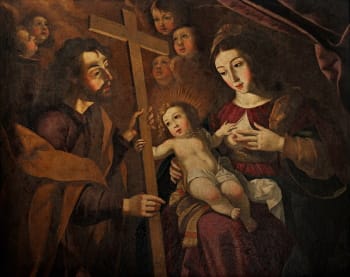
At some point before 1653, the artist was back in Óbidos with her family. There, she executed an allegory of Wisdom to be included in the Novos Estatutos da Universidade de Coimbra (the Book of Rules for the University of Coimbra), for which her father, who was by now a highly regarded painter himself, was designing the frontispiece. Still aged just 23, Óbidos accepted commissions for a number of important works for churches and convents around central Portugal, including five panels for the Saint Catherine altarpiece of the Santa Maria church in Óbidos in 1661, the altarpiece of Saint Theresa of Ávila in the Carmelite Convent of Cascais in 1672-73, and an altarpiece for the Church of the Mercy of Peniche in 1679.
Óbidos also took on commissions from private clients for portraits and still lifes, and became a member of the Lisbon Academy of Art. She was commissioned to produce an important engraving in Coimbra before working on some of Portugal's most prestigious religious buildings, including the great monasteries of Alcobaça, Batalha and Evora. She also painted the portraits of members of the Portuguese royal family. As her reputation continued to grow, noble women, having visited the nearby thermal baths, often made a point of visiting her studio. She never married (and is thought to have lived her life as a virgin) and managed to live comfortably and independently from the earnings from her paintings. She also made a shrewd businesswoman, purchasing and leasing land and acting as a money lender.
Referring to Damiao de Froes Perym's (the pseudonym for the monk, Fray Joao de San Pedro) 18th century publication, Life Stories of Woman Artists, critic Julia K. Dobbs writes, Óbidos "is justifiably included in Froes Perym's catalogue of illustrious women since she was, and still is, the best-known artist of seventeenth-century Portugal". She adds, however, that an "intriguing and somewhat puzzling" aspect of her life story is that "the artist is said to have been invited to serve the Queen at the Portuguese court [yet] despite the advantages of such a position [she] evidently turned it down". Dobbs states, one "wonders if the public reaction to and royal demands on Ayala as a painterly 'curiosity,' noted twice by the biographer, might have been uncongenial to her apparently introspective nature".
Late Period and Death
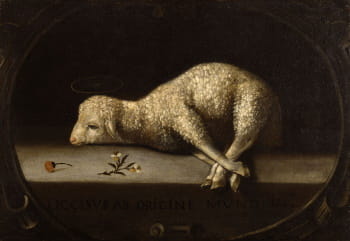
In the 1660s, Óbidos's brothers, José Ortiz and António, took religious vows. Her sister Luisa, with whom she was closest, and who had been sickly since childhood, died on January 1, 1664. According to Joaquim Oliveira Caetano, director of the Museu Nacional de Arte Antiga in Lisbon, "From then on, Josefa's painting seems to have turned again to smaller formats painted on copper, and to the still-life models [...] and, above all, to the creation of standard images of the Christ Child, the Infant Saint John the Baptist, and the Mystic Lamb". Among Óbidos's best known, and most original, still lifes, "The Months", were produced from around 1668. These reveal the artist's humble (free of symbolism) relationship with everyday objects. Following her father's death in 1674, she became obliged to undertake a higher number of public commissions in order to support her elderly mother and two orphaned nieces (with whom she had been living for some years in a large house she had purchased on Rua Direita in Óbidos).
In her will, dated June 13, 1684, Óbidos is identified as a "virgin who never married" and who had been "emancipated with the consent of her parents". She passed away on July 22, 1684, at the age of just fifty-four. She was buried in the Church of São Pedro in Óbidos. Art historian Julia K. Dabbs notes that she was laid to rest "in the habit of a Poor Clare, indicating that she may have been a lay member of the Franciscan order".
The Legacy of Josefa de Óbidos
Josefa de Ayala de Óbidos produced around 150 paintings during her lifetime, making her one of the most prolific, and the most important, female artist of the Baroque period in Portugal. Following her inclusion in Damião Froes Perym's 1736 anthology, Life Stories of Woman Artists, who called her "honest [and] talented", she was acknowledged by the Portuguese writer and painter Félix da Costa Meesen for being "acclaimed far and wide, especially in the neighboring countries [as] someone who practiced the perfections of art to notable applause".
However, Óbidos remained somewhat forgotten until 1949 when Lisbon's Museu Nacional de Arte Antiga put on a career retrospective of her work. Though dismissed as provincial by the noted Portuguese writer Miguel Torga - "Oh! this Portuguese race that does not deliver a painter who is worth the while" - as the century progressed, critical interest in her work increased dramatically with further retrospectives held to acclaim in Europe and America. Contemporary scholars, including Rachel Zimmerman and Joaquim Oliveira Caetano, assert that her "feminine condition", along with the "provincial" label attached to her oeuvre, was of critical interest in and of itself. But, says Caetano, "her painting goes far beyond being a curious case of 'gendered art' [and that] Josefa painted and lived her life with unusual independence, and truly created her own artistic language in Portuguese Baroque".
Influences and Connections

-
![Francisco de Zurbaran]() Francisco de Zurbaran
Francisco de Zurbaran - Juan Sánchez Cotán
- Agostino Verrocchi
 Ask The Art Story AI
Ask The Art Story AI